Sounds crazy, but you don't want to increase your site's traffic...
What you really want is to boost your site's value per visitor.
That's the metric you must pay attention to if you're building a conversion focused online business.
While most Search Engine Optimization (SEO) gurus teach all kinds of ways to boost your "traffic", what you should focus on is attracting the right kind of traffic (i.e. visitors with a higher conversion potential) whenever someone mentions "traffic" to you.
With that preamble in mind, I want to teach you a basic keyword research strategy for your online business in this post.
More...
Our approach to keyword research not only aims to grow your value per visitor, but helps you build a consistent content calendar to improve your marketing efforts as well.
On board with that? Read on.
So... What Are Keywords Exactly?
In simple terms, "keywords" are words or phrases that people type into search engines — overwhelmingly Google — to find information, products, or services. Keywords are also known as "search terms" or "search queries."
A Note on Search Engines:
A variety of search engines are available for internet users including:
- Baidu (a Chinese search engine)
- Bing
- Yahoo
- Ask.com
However, Google now corners the market with 77.73% of online searches (Sept 2017 - Sept 2018) according to NetMarketShare.com.
That's why the word “Google” is used synonymously with “search engine” in this post. Also, instead of mentioning every internet browser available, only Google Chrome will be referenced here to keep things simple.
Search queries range from general information seeking (e.g. “most poisonous snake”), to specific problem solving (e.g. “how to treat a snake bite”), to attempts at making commercial purchases (e.g. “pet stores near me”).
Think about how you use Google for a sec. When searching for something, you have a specific piece of information or answer to a question that you want to find.
The search engine is a tool that tries to "know" every word on every page of the Internet so it can provide you with exactly what you're looking for. Since it can never be 100% accurate, Google shows you a list of results instead, starting from "most likely to be exactly what you want" to least likely.
That means the more relevant Google deems your content for specific search terms, the higher your content will show up in the search results.
People go bonkers to improve their Google search term rankings because results one through five (a.k.a. Google Search Results Page #1) get the most clicks from users. Check out this Click-Through Rate (CTR) study from Advanced Web Ranking to see proof of that in graphical form:
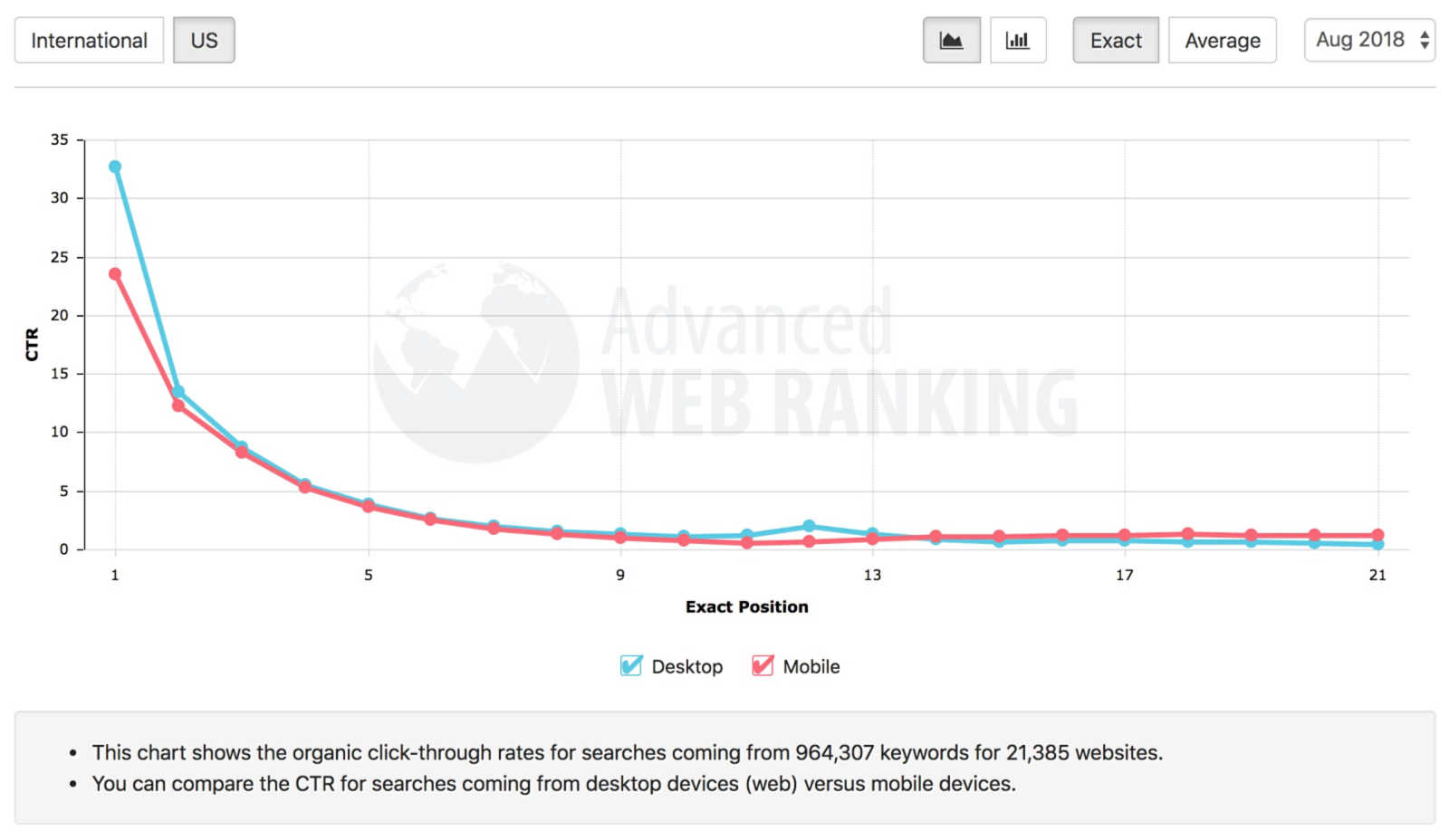
Advanced Web Ranking's organic Click-Through Rates percentages plotted against Google search result positions for 964,307 keywords on 21,385 websites. Notice almost all of the engagement occurs in positions 1-5 (Search Results Page #1).
In fact, CTR's for links that show up on pages 2+ of Google are usually so low, SEO nerds joke that:
“The best place to hide a dead body is on Page 2 of Google Search Results.”
So being in those top spots of the Google search results is great for your online business, right? Tons of free traffic!
That's true only if you're in the top spots for keywords that people actually search for and are relevant to what you offer. Otherwise, it becomes wasted time and effort that you could be spending on more important projects.
Only by creating engaging content that leverages the most value per visitor
keywords will you actually boost your business in a profitable way.
Let’s now discuss the different categories of keywords you'll need to identify in your research so you can start attracting the right kind of traffic.
Primary and Secondary Keywords
So here’s the deal. For any content you publish on your website, you'll always end up ranking for more than one keyword phrase on the page.
That’s why it’s a good idea to target one primary keyword phrase (your “must win” keyword) and a handful of secondary keyword phrases before you start creating a piece of content.
Your primary keyword will be the most competitive search term you target on your page, but offers the most traffic potential.
By contrast, your secondary keywords will fall under the same topic as the primary keyword (the parent topic), but are more niche specific. That means secondary keyword phrases tend to be less competitive and have lower search volumes. Although lower search volumes make them seem less desirable, the good news is that they're much easier to rank highly for.
In this way, secondary keywords can be super important because ranking highly for many of them on the same page adds up in terms of winning niche specific traffic.
With this in mind, try to find three to five secondary keywords for any piece of content you create.
Check out Neil Patel's video below where he discusses why it's helpful to target a few keywords before creating a piece of content. If you want to know what Neil means by the term "Long Tail Keywords", continue reading the next section.
Head vs. Body vs. Long Tail Keywords
SEO experts classify keywords further into categories that deal with the specificity of search terms. As a rule of thumb, more specific keywords get less search traffic and more general keywords get larger amounts of search traffic.
On a scale from general to increasingly specific keywords, search terms are also defined as Head, Body and Long Tail Keywords (describing the shape of the inversely proportional search volume curve being illustrated in the image below).
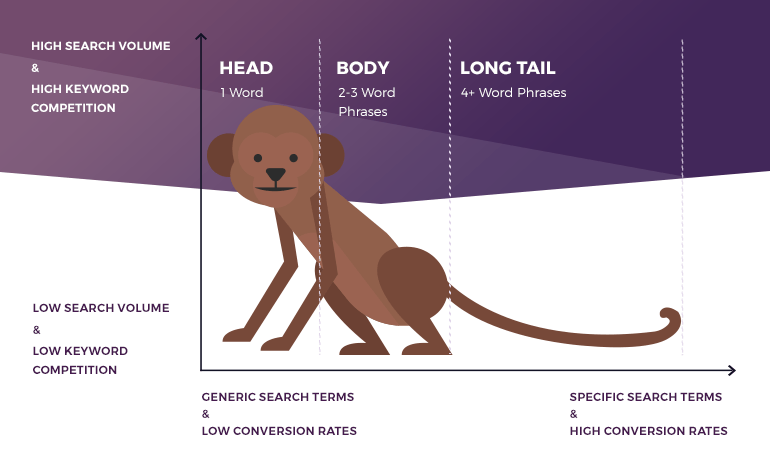
Keywords can be categorized into three groups based on how specific they are: Head, Body and Long Tail Keywords. The monkey graph above shows this relationship as well as each category's search volume, competition and conversion rate relationships.
Head Keywords
Head Keywords are usually just one to two words in length and have large search volumes. A head keyword may encompass the general topic or theme of your website.
However, these are not keywords worth directly targeting within your content because single word search terms are so general, they usually include multiple search intents not relevant to your business.
For example, if you run a cooking blog and target the head keyword apple, you would end up competing for both apple the fruit and Apple the tech company search intents.
Even though apple is a high volume keyword (3,900,000 searches per month within the US), the tech company Apple puts this search term out of competitive reach (Ahrefs, a premium keyword research tool, gives apple a super competitive keyword difficulty: 73 out of 100 on a non-linear scale).
Body Keywords
By being just a little more specific, you can niche down your target keyword for a piece of content into what’s called Body Keywords. These search terms are usually two to three words in length. Usually, your primary keywords will fall under this category.
Using our same food example as before, your body keyword for a piece of content might be apple pie recipe. This three word search term still gets lots of organic search traffic (102,000 searches per month in the U.S.), but is less competitive than apple (Ahrefs gives apple
pie recipe a less hard competitive keyword difficulty: 41 out of 100).
See where we’re going with this?
Long Tail Keywords
Finally, your Long Tail Keywords are much more specific. They're usually 4+ words in length and often comprise all of your secondary keywords.
To round out our baking example, long tail keywords for your hypothetical apple pie recipe article may include less searched for, but much less competitive terms like: dutch apple pie recipe, best apple pie recipe, and sugar free apple pie.
Check out the table below to see the search volume and competition metrics for these long tail keyword examples (pulled from Ahrefs):
Long Tail Keyword | US Search Volume | Keyword Difficulty |
|---|---|---|
dutch apple pie recipe | 8,000 (per month) | 9 (out of 100) |
best apple pie recipe | 7,800 (per month) | 28 (out of 100) |
sugar free apple pie | 1,300 (per month) | 5 (out of 100) |
If you can identify, target and win easier long tail keywords that have both low competition and promising monthly search volumes, you'll have a good chance to stack up more conversion optimized search traffic.
Also, as you begin to win these more niche specific keywords, Google will start associating your site as the leader in "apple pie" related content. The big picture benefit there is that you'll find it easier to rank higher for any future pie related content you create.
Over time, Google will then see your site as an authority for all types of pies making it easier for you to rank for desserts. As your site becomes an authority on desserts, it will be easier for you to rank for another genre of food.
If used strategically like this, keyword research becomes a valuable tool to help you find initial content opportunities to first establish yourself and then grow.
Use Keyword Research To Generate Better Content Ideas
So now that you know what the different types of keyword categories are, it’s time to do the work of finding new search term opportunities for your website.
Think about keyword research in the following steps not just as a way to SEO optimize your content, but as a long term, low effort content calendar builder.
Here’s how to get started...
First, Brainstorm Your “Seed” Keywords
Seed Keywords are just your starting point search term ideas.
Begin by taking a few minutes to record the words you use to describe your website, content topics, and niche online market. To do this right, describe each of these as you would to a friend over coffee.
For our baking website example, this would drum up initial seed keywords like: dessert, pie, cake, etc.
Identify all the potential keywords in your descriptions and then record them in a spreadsheet tool like Google Sheets or Microsoft Excel.
After completing this thought exercise, you’ll have a list of seed keywords to broaden your research from. Next, you’ll take those first approximations and use them to gather real world data from Google.
Expand Your Seed Keywords with Google’s Auto Suggest & Related Search Terms Features
Ready for some great news?
Some of the best — and free! — initial keyword research you’ll do is on the Google Search Page itself!
There are two features on the Google search page that will give you new keyword winners to add to your list:
1. The Search Bar Auto Suggest Drop Down Menu:
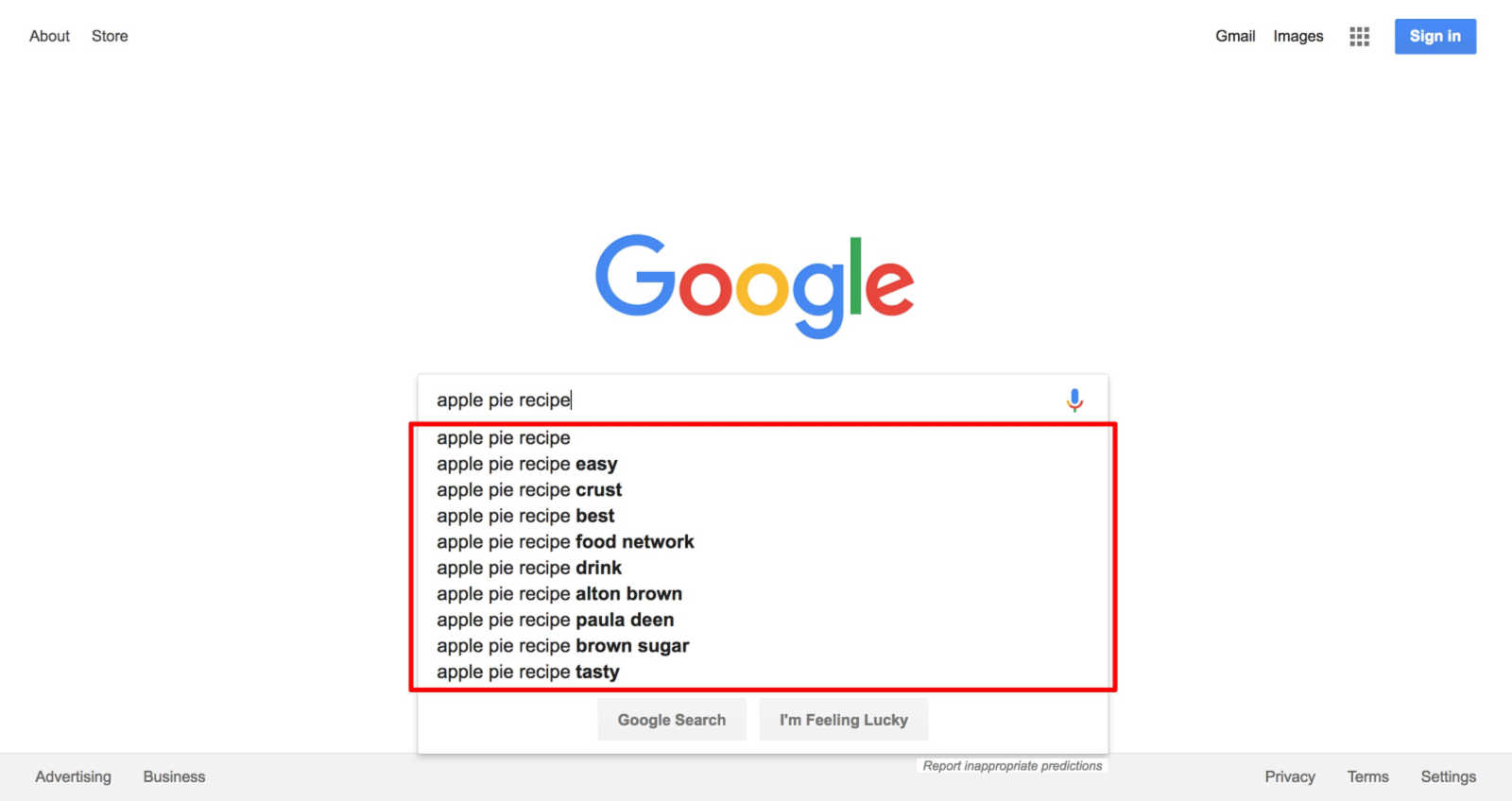
Whenever you start typing search terms into the Google Search bar, an auto suggest dropdown menu will appear with related search terms for you to consider. These are actual keywords people are using within their Google searches so record any relevant ones that appear to help your keyword research efforts.
2. The Related Search Terms offered at the bottom of your Google Search Results page:
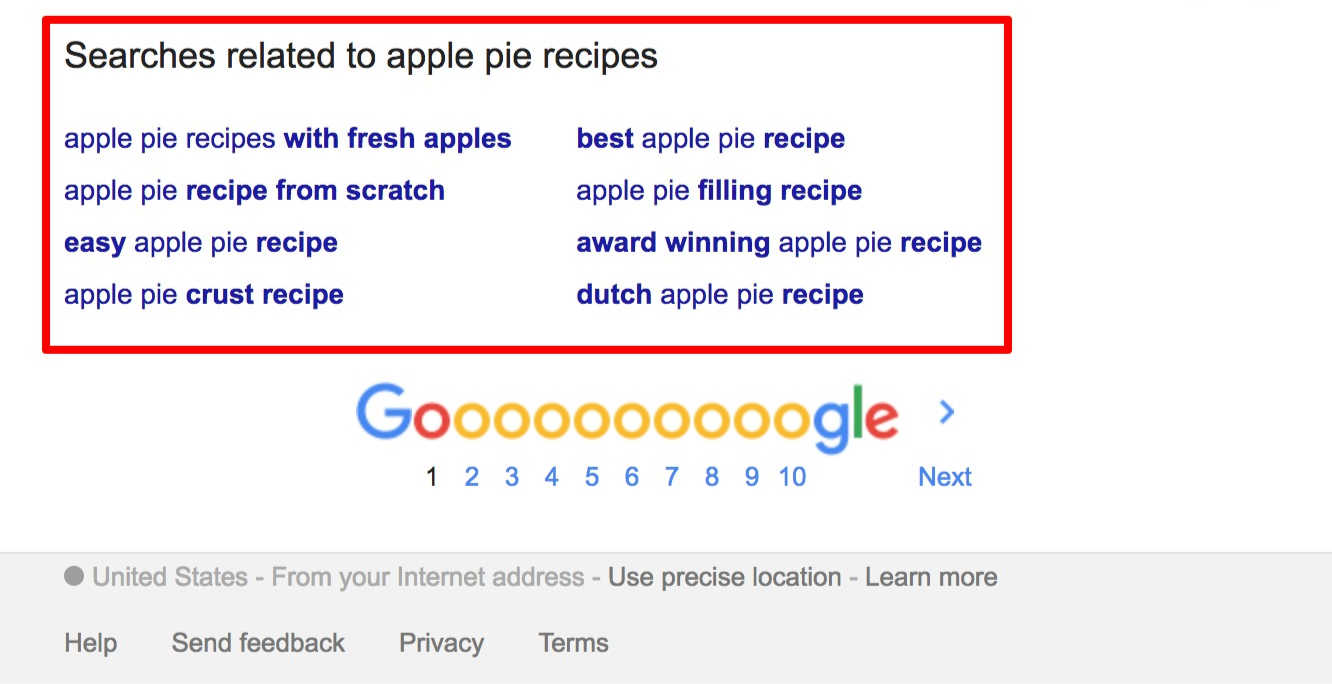
Every time Google completes a search for you, it provides related search terms at the bottom of the results page for you. Read through these related terms and swipe any that are relevant to your keyword research.
These two Google search features are amazing because Google is literally telling you what the top related search terms are compared to each of your seed keywords.
To get started recording these related search term discoveries into your keyword research spreadsheet, open a Google Incognito Window with Chrome. This Incognito Window step is important because it prevents Google from biasing your research results with your own personal search history!
If you don't want your current country location to bias your research results, type “google.com/ncr” into the URL box at the top of your Chrome browser (a.k.a. the Omnibox). This link will open a No Country Redirect (NCR) Google Search Page.
After those setup steps, start plugging each of your seed keywords into your sanitized Google search bar.
Next, record the relevant auto-suggested keywords that pop up pre-search into your spreadsheet.
Then after each search result loads, scroll down to the bottom of the page where the related search terms area displayed and copy the relevant related search terms into your research spreadsheet.
Repeat this process with your current list of keywords until you’re satisfied you’ve collected all the relevant search terms Google has to offer you.
My, my, my… look how big your keyword list has grown in such a short time!
Sort Your List Into Primary and Secondary Keywords
Before you move on, take a few minutes to run through your current research spreadsheet and categorize what you have into the 2 main groups we discussed earlier: your primary and secondary keywords.
I recommend you do this in two steps:
- Do a first pass sorting of your current list into the two groups according to keyword phrase word length. Use the rule of thumb that primary keywords are three words or less and secondary keywords are 4+ words just to get started.
- Now evaluate the two search term groups in a second pass to check that your primary keywords feel like parent topics and your secondary keywords feel like specific support topics. Make any adjustments you need to the two groups to establish this balance.
In the pie example, your primary keyword list might start to look like:
- apple pie recipes
- chocolate pie recipes
- meat pie recipes
Going down the apple pie recipes related content thread, secondary keywords might begin to include:
- apple pie recipe from scratch
- easy apple pie recipe
- Dutch apple pie recipe
- sugar free apple pie recipe
Use Free Tools to Collect Data and Refine Your Keywords
By this point, you should have a large list of search terms that are based on what people actually type into Google.
Your next step is to use some of the free keyword tools out there to help refine your list of search terms and complement them with actual data.
These tools will provide you with the important metrics you need to categorize, organize, and prioritize your keywords including:
- Monthly search volume estimates
- Keyword difficulty (organic) and/or keyword competition (paid)
- Cost Per Click (CPC) price ranges
A Note On Free Keyword Data:
It's important to know that the keyword data provided by each of these free tools are basically rough estimates.
But even though the search volume and competition ratings are not exact, they will help you find subject opportunities to make your content planning more strategic.
By recording each of these pieces of data, you’ll get a better sense of each keyword’s organic and paid traffic potential. Like I mentioned before, you’re looking to identify and exploit search terms that have large search volumes and low competition.
Here’s a rundown of the free keyword data-mining tools at your disposal:
Google Keyword Planner
Although the Google Keyword Planner (GKP) isn’t the most user friendly tool around — because it’s built with advertisers instead of content creators in mind — it provides rough search volume estimates, Google Adwords competition ratings (e.g. Low, Medium, High), and CPC price ranges.
Understand that the GKP competition ratings reflect the difficulty to win paid traffic through Google Adwords and not how hard it is to win organic search traffic. Organic and paid keyword difficulty (KD) ratings are often the similar, but not always.
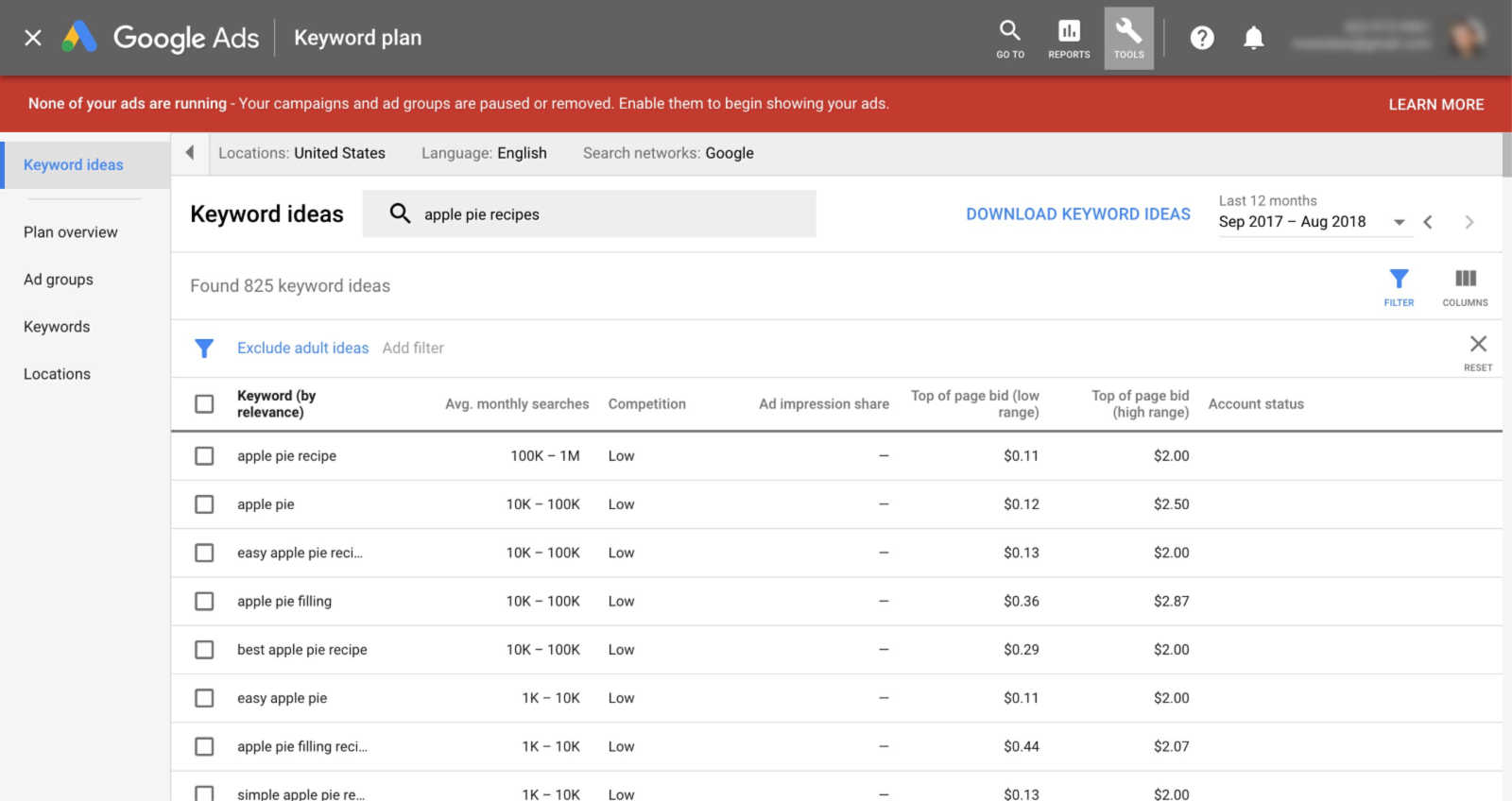
The Google Keyword Planner (GKP) dashboard.
You can follow Brian Dean’s step-by-step guide on Backlinko.com if you want to learn how to set up your own Google Keyword Planner account.
Note: If you're finding GKP too complicated, skip down a few paragraphs to where I talk about the next tool called Ubersuggest.
Type your keywords into the Keyword Planner tool (you can input multiple keywords at once) and then record their estimated organic search traffic volume, Adwords competition ratings, and CPC price ranges in your spreadsheet.
And because Google uses GKP to sell ads, it offers you related keyword suggestions that usually have stronger purchase intents associated with them. If you see any GKP suggestions that look promising, add them to your spreadsheet — still sorting them as either primary or secondary keywords.
Finally, GKP also allows you to enter website and page URLs in place of keywords to show you what your competitors are already ranking for.
If you get a GKP account setup, make sure to plug your competitor URLs into GKP and record the Adwords search terms they're currently ranking for in your spreadsheet.
UberSuggest
A free tool that’s much simpler to use than GKP is Neil Patel’s Ubersuggest.
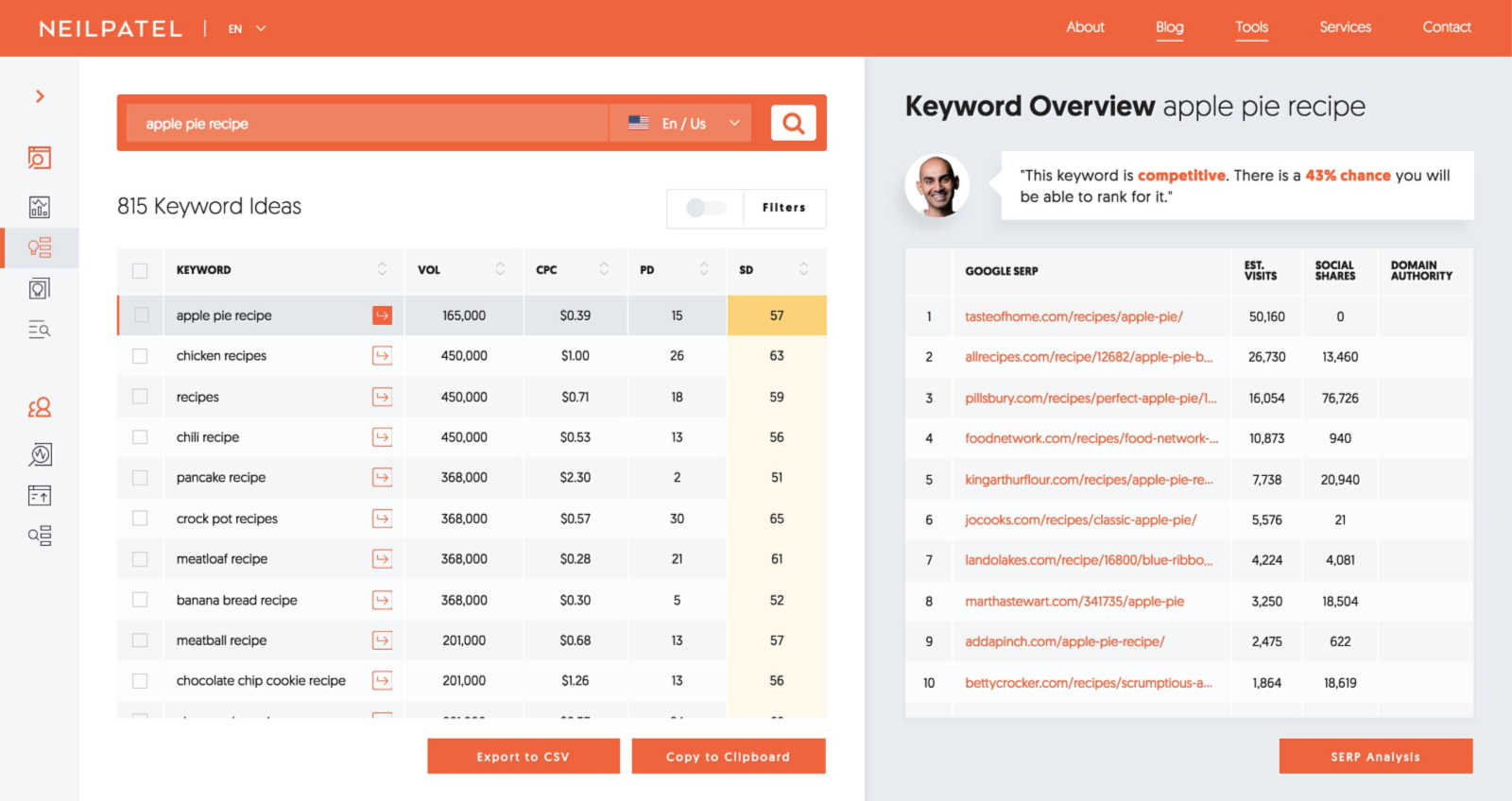
Ubersuggest's Keyword Idea dashboard showing several related keywords and top ranking web pages for the search term you entered.
Ubersuggest works a lot like paid keyword search tools (e.g. Ahrefs) providing you with everything from estimated monthly search traffic, organic vs paid keyword difficulty, related keyword suggestions (keyword ideas) and the top pages ranking for individual search terms.
Ubersuggest even shows you recent search trend data, which is useful for understanding whether or not the keyword you’re investigating has growth potential.
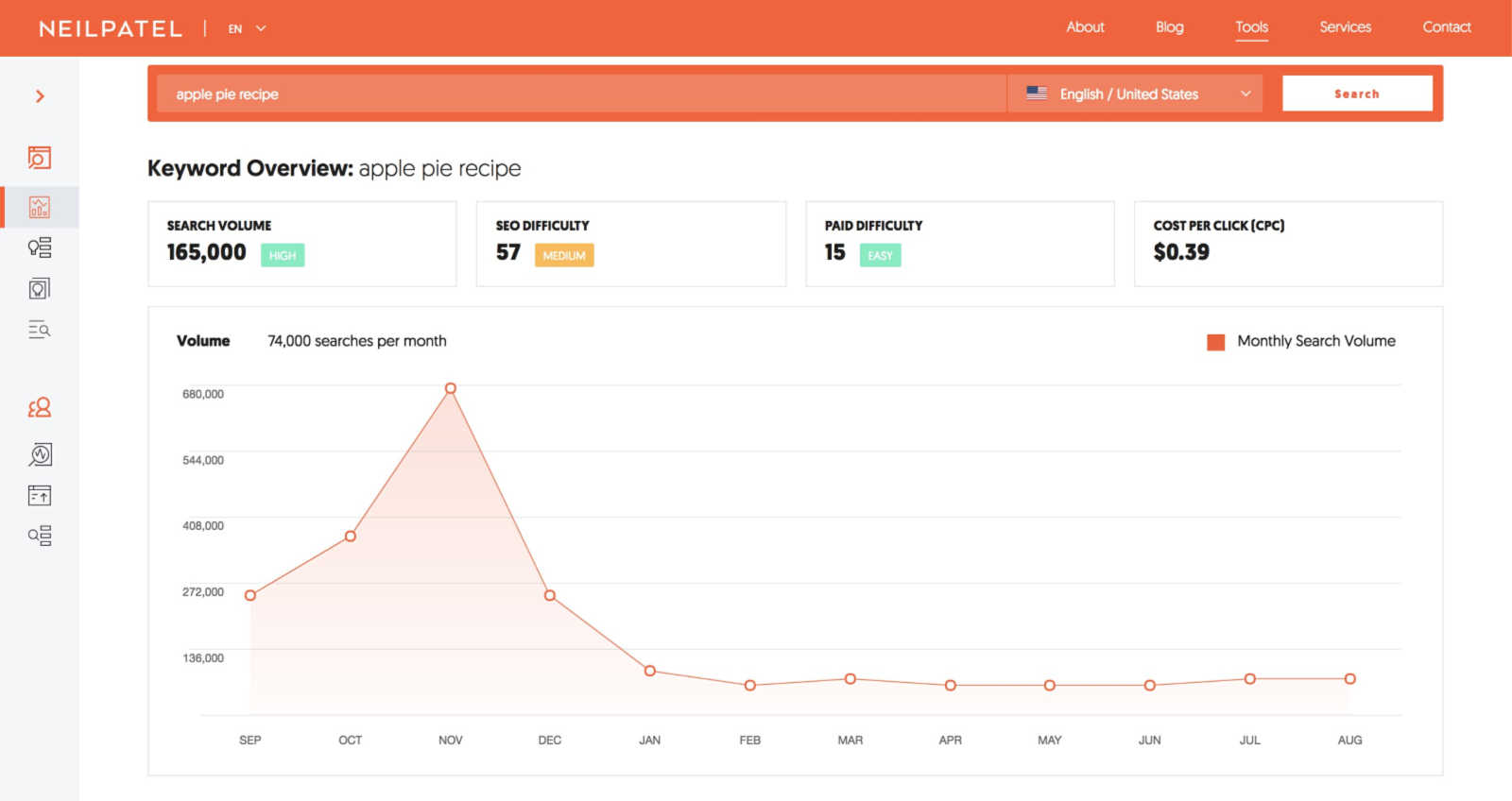
Ubersuggest's Keyword Overview dashboard showing the data metrics including estimated search volume, organic search difficulty, paid traffic difficulty, a CPC price estimate, and the recent search volume history trend.
Answer the Public
Yet another free keyword research tool that specializes in helping you find informational and "how to" keyword opportunities is a website called AnswerThePublic.com:

AnswerThePublic's homepage is complete with a frustrated man waiting for you to input your keyword query.
When you use AnswerThePublic, you’ll notice that the free version of the tool limits you to the UK data only. Although that might not be your target customer country, it’s good enough to help grow and further categorize your keyword research list.
When you do a keyword search on AnswerThePublic, don’t be overwhelmed by how many related search terms it offers you.
The results are organized into five novel categories:
- Questions: [your search term] + [question words/phrases]. What, why, how, etc. (e.g. “What’s the best apple pie recipe”).
- Prepositions: [your search term] + [prepositional phrases]. For, with, can, etc. (e.g. “apple pie recipe for diabetics”).
- Comparisons: [your search term] + [comparative phrases]. Like, and, with, or, etc. (e.g. “apple pie recipe with homemade crust”).
- Alphabeticals: [your search term] + [a words, b words, c words, ...]. This category returns lists of related search terms running through each letter of the alphabet (e.g. “apple pie recipe american” all the way through “apple pie recipe lemon zest”).
- Related: [your search term] + [related terms] (e.g. “apple pie recipe jamie oliver”).
Notice that most of these results take primary keywords (i.e. more general head or body keywords) and locates relevant secondary keywords (i.e. more specific long tail keywords) for you. The results also tend to be informational and "how to" in nature compared to GKP's more commercial bias.
Pro Tip: Upgrade Your Basic Keyword Research Experience with a Free Google Chrome Extension
Keywords Everywhere is a slick Google Chrome extension that you can use to help speed up your basic keyword research.
In fact, we liked it so much that we included it as was one of our must try 20 + 1 Google Chrome extensions on the Thrive Themes blog.
Here’s how it works:
For any search term you type into Google, Keywords Everywhere will show you the GKP estimated monthly search volume, CPC price and Google Adwords competition rating for that term.

The Keywords Everywhere Google Chrome extension at work beneath the Google Search bar.
Keywords Everywhere also provides you that data for:
1. “Related Keywords”

The Keywords Everywhere Google Chrome extension presents a "Related Keywords" box in the Google Results Page sidebar.
2. “People Also Search For”
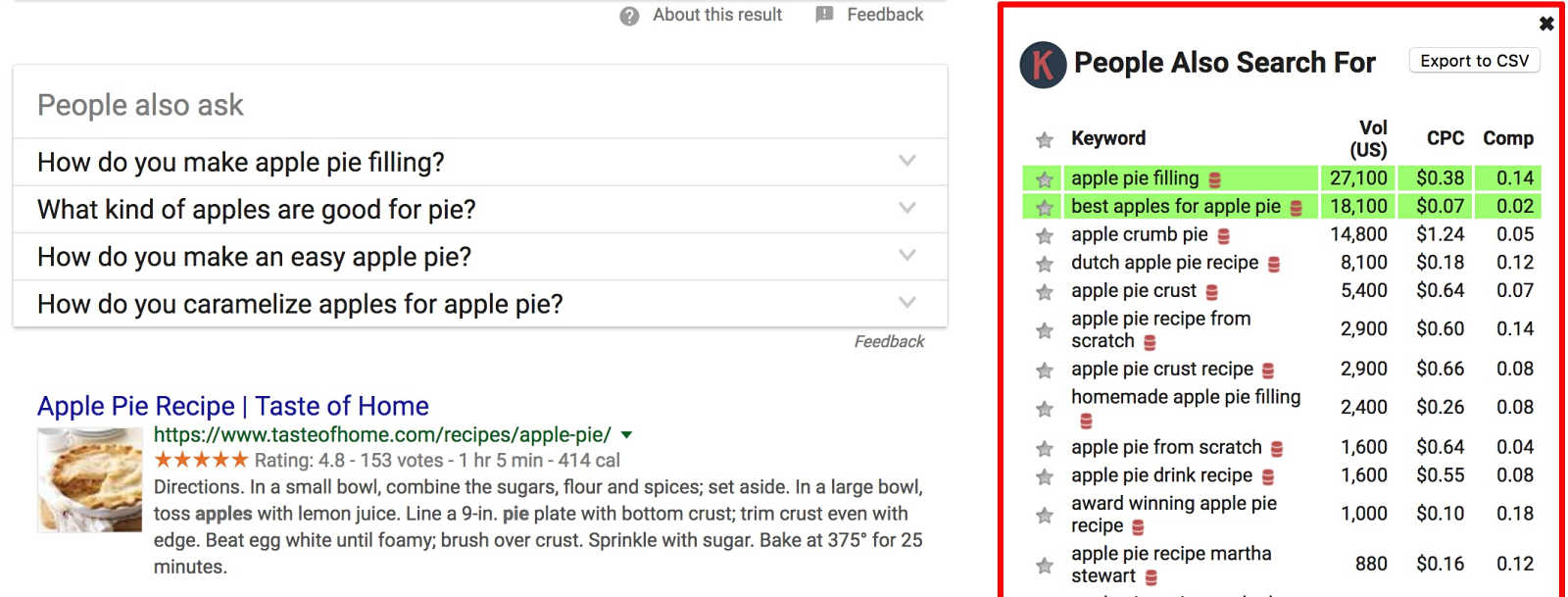
The Keywords Everywhere Google Chrome extension presents a "People Also Search For" box in the Google Results Page sidebar.
3. “Searches Related To”
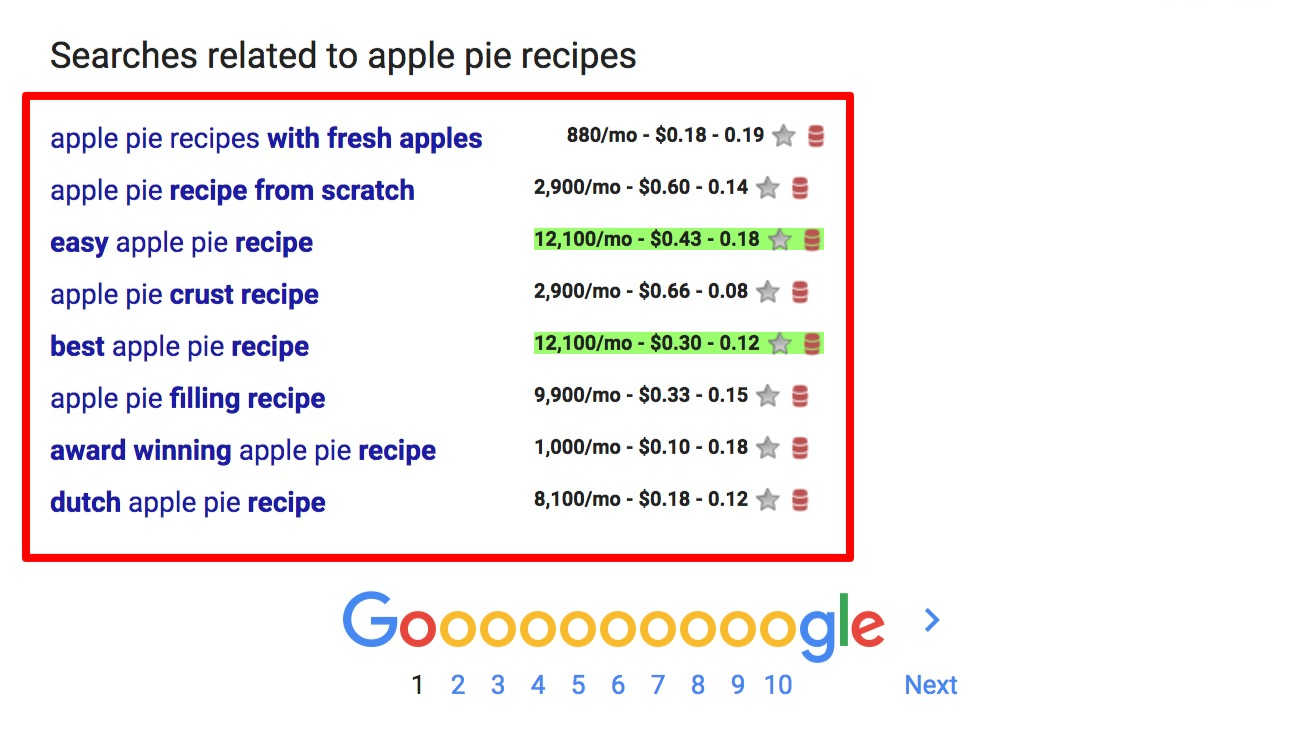
The Keywords Everywhere Google Chrome extension at work on the Google Results Page related search term feature.
Notice that the Keywords Everywhere extension will even highlight keyword opportunities for you in green based on the search volume and competition cutoffs you set for it in the extension settings.
On top of that, Keywords Everywhere works on sites like AnswerThePublic, providing the same search volume and CPC data in its Alphabetical results section:

The Keywords Everywhere Google Chrome extension at work on the AnswerThePublic Alphabeticals results section.
Not bad, right?
This quick look tool can help you find more valuable keywords in a fraction of the time.
Google Trends
Another free Google tool you should run your keywords through is Google Trends:

The Google Trends Results Page with the Keywords Everywhere Google Chrome extension activated.
When you type your search term into Google Trends, you can instantly see trends in how people have been searching Google with different keywords over time.
In the example above, I set the time frame from 2004 to present (Google data goes back as far as 2004), and the “Related topics” and “Related queries” sections to “Top” instead of “Rising”.
When examining the “Interest over time” graph for the apple pie recipe keyword example, you acquire the following insights about this content topic:
- Interest in apple pie recipes is seasonal. Like clockwork, searches for this keyword spike each November. With a little more investigation, you realize that apple pies are a hallmark dessert for the Thanksgiving holiday in the U.S. soooo...
phenomenon explained.
- The overall interest in apple pie recipes peaked in 2013 and has shrunk ever since. Don’t expect growth in the apple pie market anytime soon. 😉
Insights like this are important so you can optimize your content schedule for seasonal events or holidays where appropriate.
And even though you can’t get detailed search volume data from Google Trends, it’s great for checking whether or not there's a growing interest in your keywords.
If you do see a growth trend, it makes sense to invest some time creating content around the topic to capture future visitors when the topic becomes more mainstream.
Keyword Research with Wikipedia, Reddit, Quora and Online Forums
Finally, it’s worth doing a quick search through Wikipedia, Reddit, Quora and relevant online forums for your niche to see whether or not you can drum up a few more keywords that reflect the specialized lingo of your target audience.
Take your primary keyword list and see if any of the search terms have a Wikipedia page. If so, investigate their "Contents" section as it can provide several more related keywords prime for the taking:
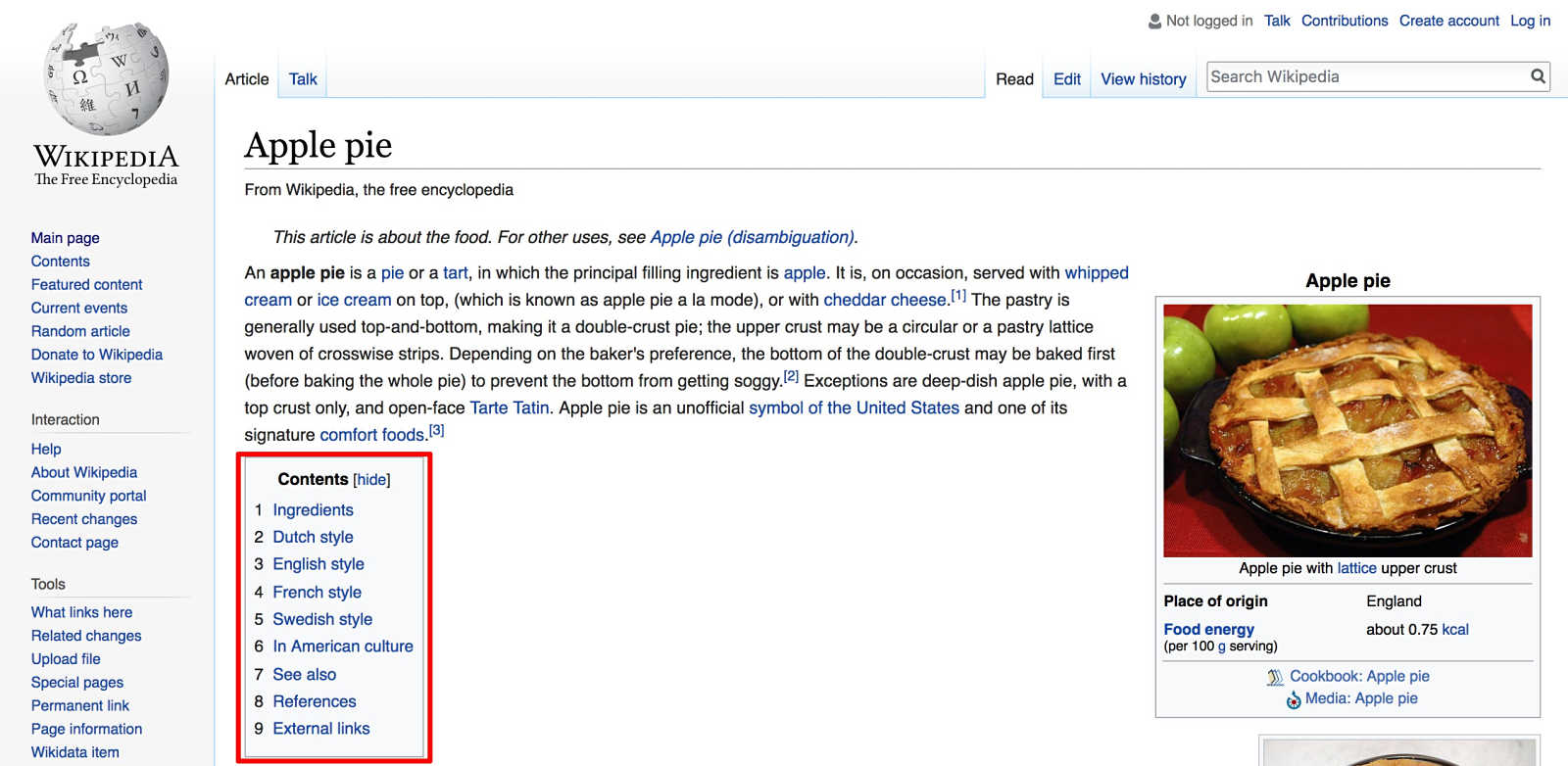
The "Contents" section on many Wikipedia pages is a great place to get new related keyword ideas.
Likewise, Reddit.com can give you a treasure trove of new search terms and content ideas:
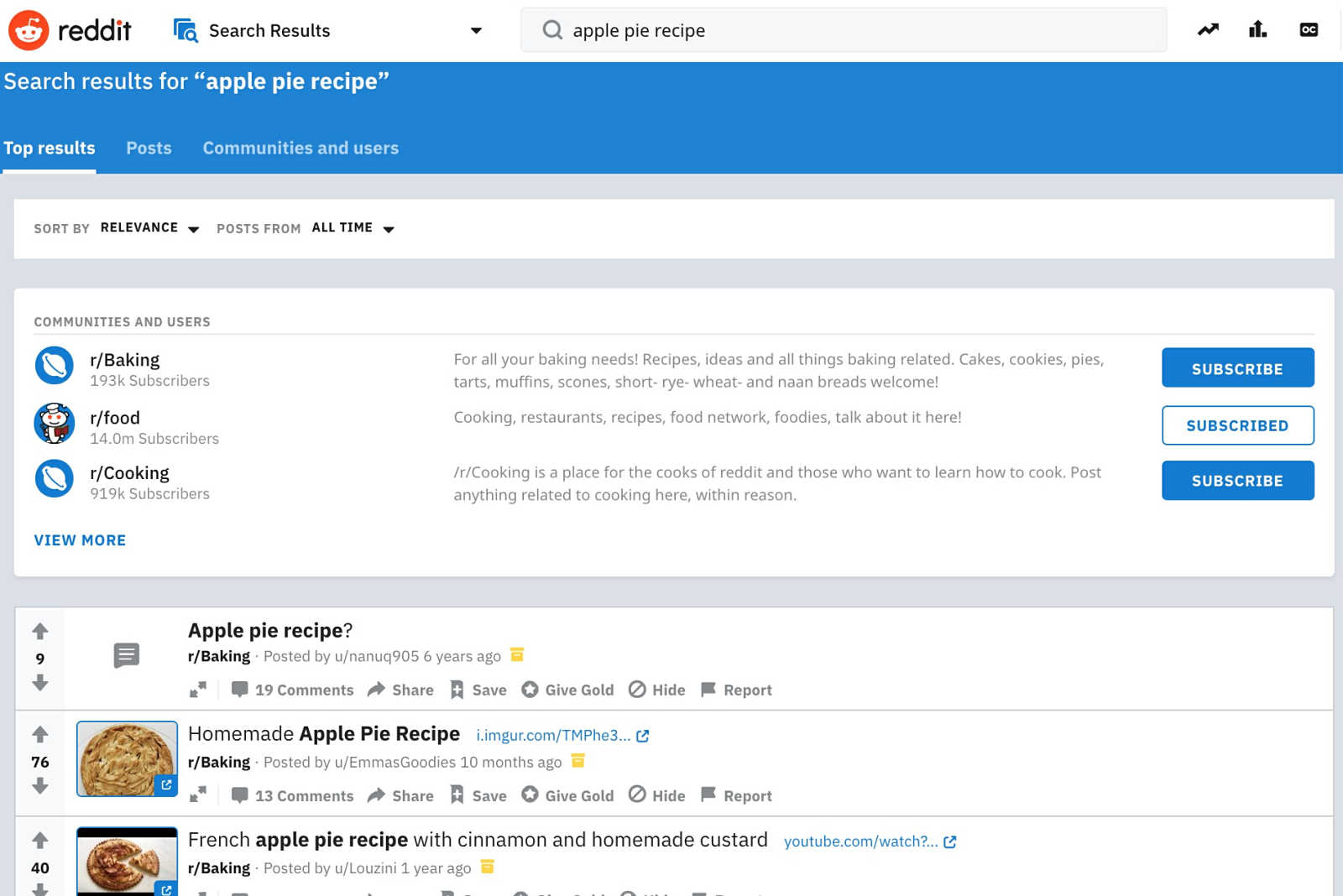
Using your list of primary keywords to search Reddit with can help you come up with more keyword and content ideas you may have missed.
By plugging your primary keywords into the Reddit search bar, you’ll get a list of related subreddits (like r/Baking, r/Cooking and r/food for the search term apple pie recipes) as well as several related Reddit comments.
Comments are a great place for new content ideas since most people are posting topics they need help with.
Finally, Quora.com can be another useful keyword research tool for generating niche content ideas. On Quora, people are asking and answering questions around niche problems so the keywords and content ideas it helps you generate will probably be useful for your target audience too.

Look through Quora for interesting content ideas and potential keywords you missed around your niche topics.
TIME SUCK WARNING:
Don’t let yourself waste time going down any Wikipedia, Reddit and Quora rabbit holes when doing this part of your keyword research.
The aim here is to do a quick final check on your keywords research list to identify any search terms or content ideas you may have missed earlier using the more traditional tools.
When it comes to your keyword research, remember to use Rapid Implementation Principles to keep yourself from going overboard.
Target the Low Hanging Keyword Fruit
So far, you've used your brainstorming and some free tools to build a list containing as many potential keywords for your niche content as possible.
If that list looks intimidating, don't worry. It's time to start eliminating keywords that are either too competitive or just don't fit the content strategy for your site right now.
To do this, you're going to use all the metrics you collected with your keywords to arrive at a strategic list that will help you create both optimized and engaging content.
Here's how to pare down your list to the most valuable keywords:
Step 1: Eliminate all the secondary keywords that don't have easy competition ratings. Eliminate all the primary keywords that have high competition scores.
However, competition and keyword difficulty is judged differently by different tools.
Use the following table as a guide for the free tools we discussed in this post (Ahrefs is a paid tool, but I included it here for comparison).
Tool | Easy KD | Medium KD | Hard KD |
|---|---|---|---|
GKP | Low | Medium | High |
Ubersuggest | 1 - 30 | 31 - 70 | 71 - 100 |
Keywords Everywhere | 0.00 - 0.30 | 0.31 - 0.70 | 0.71 - 1 |
Ahrefs | 0 - 10 | 11 - 30 | 31 - 100 |
NOTE: Upon cross-checking Ubersuggest against premium tools like Ahrefs, it appears to be less reliable when it comes to identifying "easy" keyword difficulty opportunities. To be safe, aim for easy KD ratings in the 1 to 20 range when using Ubersuggest.
Step 2: Eliminate any keywords that don't fit with the current products or services you're selling (or affiliate marketing products you're promoting). Remember that you want high value per visitor traffic and this step will help your content maintain that focus.
Step 3: Eliminate keywords that have very low to no search volumes. Use your judgement here as to what search volumes are "too low" based on the youth and current domain authority of your website.
For young and relatively unknown sites, targeting lower volume keywords (in the upper tens to low hundreds of searches per month) may still be a good idea starting out.
Step 4: Take your remaining keywords and run them through Google Trends. If interest in search terms are trending up (search interest is growing), these are great keywords to start winning now.
If your site becomes the leader for these less competitive, but trending keywords early, you'll reap the organic traffic rewards in the future when the search terms go mainstream.
Commercial vs. Informational Keywords
Now that your keyword research list is narrowed down to the strongest candidates, it's time to understand which have the most commercial conversion potential.
Do this by ranking your remaining keywords in order from highest to lowest commercial search intent.

Commercial search intent is a scale concerned with how likely a person is to make commercial purchases (as opposed to just acquiring free information) based on the search terms they use.
As you might guess, the higher a keyword’s commercial search intent, the more monetization potential it has.
Remember once again that the job of your website is to reach more potential customers, not to simply attract greater volumes of traffic.
For example, would you rather attract 10,000 organic search visitors to your site every month with no intent to buy your product or 1,000 visitors per month that are much more likely to buy your cookbook about pies? I think the choice is clear.
By understanding the commercial search intent behind your keywords, you'll keep your value per visitor metric in sharp focus when scheduling your future content.
Organize Your Keywords into Unique Content Groups
So now that you have a solid list of primary and secondary keywords — with all the important search data to go with them — it's time to organize them all into unique pieces of engaging content.
If you look at the entire process from brainstorming your seed keywords to organizing your research into potential content pieces, you get logical groups of keywords that look like a tree.
I call it the Keyword Research Content Tree shown below:

The Keyword Research Content Tree. A visualization to help understand keyword category relationships and the content generation process keyword research can help you with.
Your keyword groupings will become the basis for new pieces of search engine optimized content you create for your website.
Here's how our Apple Pie Recipe example fits into a branch of the Keyword Research Content Tree model...
- Seed Keyword Ideas (Head and Body Keywords):
- dessert
- pie
- apple (fruit)
- Primary Keyword (Usually Body Keywords):
- apple pie recipes (Medium KD, 165K searches)
- Secondary Keywords (Body and Long Tail Keywords):
- American apple pie recipe (Easy KD, 70 searches)
- Dutch apple pie recipe (Easy KD, 8K searches)
- French apple pie recipe (Easy KD, 720 searches)
- healthy apple pie recipe (Easy KD, 480 searches)
- vegan apple pie (Easy KD, 3.6K searches)
- vegan apple pie recipe (Easy KD, 800 searches)
- sugar free apple pie (Easy KD, 1.6K search volume)
If you did a good job categorizing all your keywords like this, your primary keywords should act as the parent topics for new post ideas and the secondary keywords should act as their supporting points or subheadings.
This strategy not only makes new pieces of content more optimized for Google (since keywords found in subheads and paragraphs of your posts are one of Google's ranking factors), but more importantly, it helps you write more engaging articles for your readers.
Look for smart ways to group and structure your keywords to build coherent pieces of content like this potential apple pie recipe article:
Grouping Your Keywords Into Unique Content:
- (H1) Page Title - The Ultimate Guide to Apple Pie Recipes
- (H2) SubHeading - American Apple Pie Recipe
- (H2) SubHeading - Dutch Apple Pie Recipe
- (H2) SubHeading - French Apple Pie Recipe
- (H2) SubHeading - Healthy Apple Pie Recipe Alternatives
- (H3) Subheading - Vegan Apple Pie
- (H3) Subheading - Sugar Free Apple Pie
The Keyword Research Long Play: Create Your Content Calendar
If you’re serious about content marketing, then you can step up your game by applying your keyword research to build a search engine optimized content calendar.
Instead of struggling to come up with new content topics each week for your blog, you can use your vetted keywords to put that planning on autopilot.
Take all your new content ideas and schedule them on your content calendar for the weeks and months to come.
This extra planning step will not only help you deliver search engine optimized content, but will also keep you on a consistent publishing schedule — one of the most powerful ways to grow a high converting audience of loyal fans!
Write Better Blog Posts Faster
Did you know you can use the Thrive Architect editor to build more than just landing pages?
One of the best ways to make your blog posts more engaging to upgrade them with a pro design appearance.
If you're interested to learn how, read Hanne's post and watch her video showing exactly how you can write better blog posts faster with Thrive Architect.
It’s Your Turn To Do Some Research
Now that you know what keywords are, how to find them and then how to apply them to create search engine optimized content, it’s time to put the tools and theory you learned here into action.
The point is not to waste time endlessly searching for the perfect keywords…
...but to spend the minimum amount of time necessary finding keyword opportunities you can write content around that brings you more conversions.
So go ahead. Give these free keyword research tools and strategy a try and let me know what you think!
If you have any questions, comments or hacks of your own to find killer keywords and content ideas, let me know all about it in the comments section below!











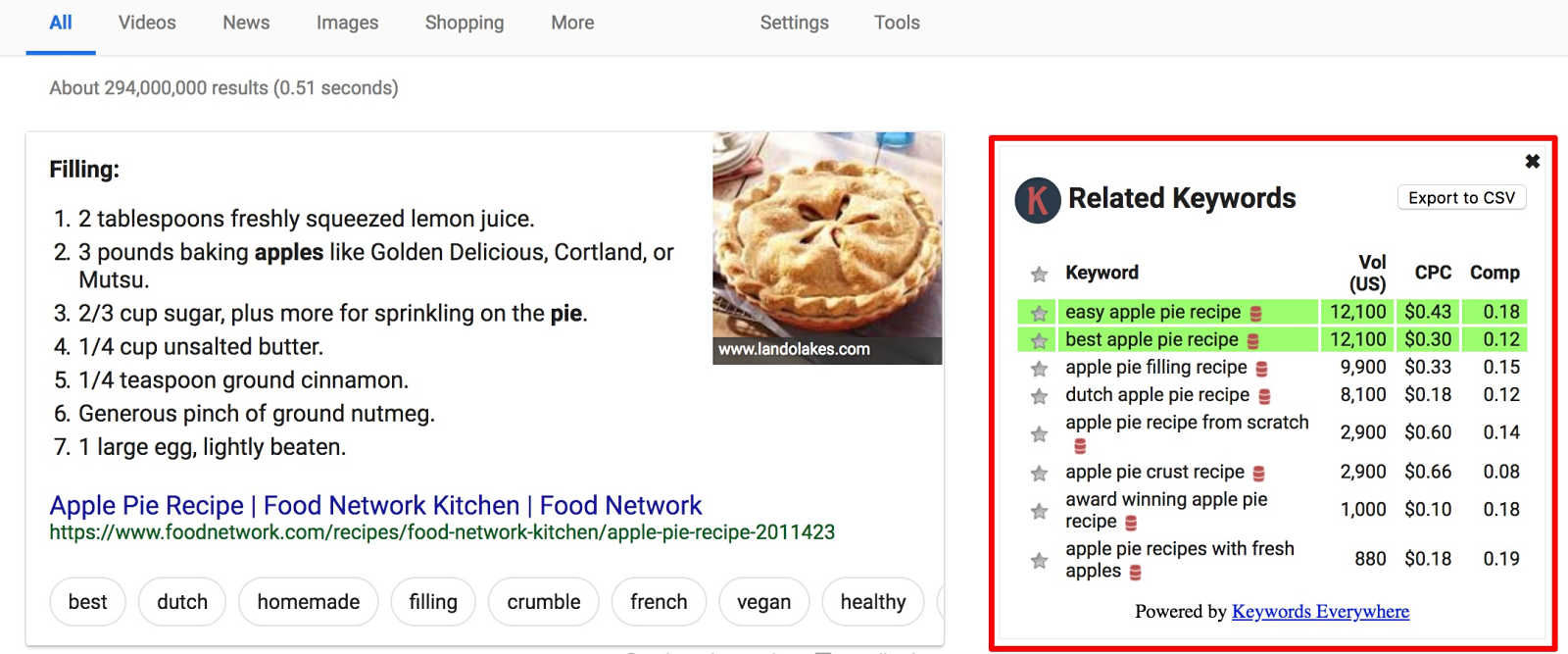







WoW! Excelent. Thank you !!!
Thanks a bunch Arturo!
@Matt – Excellent article. Clearly a lot to work through here. Thank you.
Many thanks Christopher… I hope it’s a useful resource for you!
So in the kw grouping example post above. Which word would that post be actually trying to rank for?
Hey Johnny, we’re actually trying to rank for the primary keyword (apple pie recipe) and all the secondary keywords that support it (american apple pie recipe, healthy apple pie recipe, sugar free apple pie, etc.)
Since many of the secondary keywords support the primary keyword topic, winning those should also give us a better shot at ranking for the more competitive primary keyword.
Don’t forget – Keywords Everywhere does not show a “keyword difficulty” score, it shows the advertiser competition from Google Adwords. It is a scale reflecting the number of people bidding on ads for that keyword.
Hey Tao, very good point to reiterate. Like I mentioned in the article:
“For any search term you type into Google, Keywords Everywhere will show you the GKP estimated monthly search volume, CPC price and Google Adwords competition rating for that term.”
Very informative and organized article, thank you Matt for all the tools you explained. it worth to give a try and search for gold keywords on search engine. 😀
Thanks John and happy keywords hunting!
Excellent article!!
Thanks Erik!
Great article Matt! I’m excited about the UberSuggest tool. Neil rocks!
Thanks Jonas! Yes, it’s a cool free tool to get a feel for your keyword landscape. I’ve compared it with premium tools like Ahrefs and Ubersuggest’s results are usually in the ballpark when it comes to keyword difficulty rankings and search volume estimates.
Thanks for this valuable information. I’m going to try out the recommendations.
Cheers Bakari… best of luck with your keyword research!
Excellent article! These tips are pretty good, and you even organized it into different sections, loved it. I think that many beginners will find this pretty useful, and more advanced folks can use it as a refresher.
Thanks so much for your comment Polash! That’s exactly what I was hoping to achieve with this article.
Thanks for this informative article Matt.
Just wanted to bring to your attention and of other readers that UberSuggest now owned by Neil Patel is giving mostly an ‘EASY Rating’ to rank for many keywords, even main head keywords that all other tools are stating clearly that they will be difficult to rank for including KWFinder, Google Keywords Tool, Moz, AHrefs and manual competition research
So it seems that UberSuggest is clearly NOT reliable – try it for yourself over many niches and main keywords.
Also it would be great for many people starting out with new websites if you could go in more detail about finding niches and those very first steps evaluating keyphrases and search terms with competition analysis.
As we know most seed and primary keywords are mostly dominated in the search results by huge organisations and would be a waste of time for most people to try and compete for these phrases, so some direction on niche/authority site ideas and exactly how to research would be a great idea and how to build sites around these topics.
Thanks
Thanks for your comment Dave!
It does seem that Ubersuggest rates more search terms with an “Easy” keyword difficulty than premium tools like Ahrefs do. I cross-checked Ubersuggest against Ahrefs however, and Ubersuggest always appeared to be within the same ballpark so I felt like it was still a good free tool for beginners to use starting out.
On your suggestion, I’ll add a note to the post to highlight this reliability issue though.
As for helping people discover niche opportunities from scratch, I think that warrants it’s own post and may be more suited for Shane’s ActiveGrowth entrepreneurship blog.
Although this article was written for beginners, it assumes that they already have a business or are working towards on in a niche they’ve already settled on.
Thank you for your reply Matt, I’ll also check out Shane’s pages
Great post, Thanks for share
Cheers Anik!
Thanks for this Matt! It is super helpful for a beginner and poor blogger like myself.
Many thanks Kristin and happy blogging!
Great stuff Matt! I’ve seen all/most of the advices before but this blog post puts them in a nice and digestable package… man I need to practice my blog post writing! ???? Well written indeed.
Cheers Tor…really glad to hear the post was so useful for you!
Wonderful, work to do. Where can i find soeminformation on the content calendar?
Hey Christiaan,
Check out the blog post from CoSchedule to learn all about how content calendar templates.
Finally, a good post about keyword research. Although it suffers from the same weakness as similar posts for newcomers to the topic: At least in the beginning, it fails to explain what to actually do with all those keywords.
From all the content about keyword research out there I always knew this was somehow important. But I never got how to apply it. I thought I’d have to do keyword research for earch article I’d write and then optimize its content around these keywords. This would have produced very unnatural-feeling texts though, so I never did this. Also, it felt like way too much hassele to do this for each and every post.
Only at the very end of this post I finally understood that I had it the wrong way around all along: it’s all about doing the research once, prior to writing anything, to find out and plan ahead of time what to write about. And then you just keep in mind the targeted keywords while writing.
A true eye-opener 🙂
Thanks for your comment Markus!
Yes, I look at keyword research as a modern day market research strategy to help you create and deliver the content people are actually searching for. If you see trends coming ahead of time, you can be the market leader for those topics by the time they go mainstream.
And exactly like you say at the end of your comment, if you do your keyword research periodically, then you can plan out your content topics ahead of time and keep your target keywords in mind while you write your high quality content.
Glad to hear the post was helpful for you!
Awesome.. Could you show an example/illustration of the content calendar? Can’t really picture how does the calendar look like.
Thanks Cheefoo. I’ll create an image and add it to the post for you to illustrate what a simple content calendar looks like. In the meantime, think of your content calendar like this:
If your goal is to publish a blog post once a week, you can choose a day of the week to do that… say every Tuesday.
Now create a content calendar for the upcoming month by scheduling the new blog post ideas you got from your keyword research on each of those Tuesdays.
The content calendar is also a great place to schedule things like product launches or important updates.
Thank you for the step by step guidance with lots of specifics like ‘google.com/ncr’, Matt. I’m going to have this post beside me as I do my keyword research today : )
Awesome stuff Li!
Excellent article Matt. I received an email notification about the post and followed the link to see this monster post. It’s a good one!
Thanks so much Victor!
Thanks Matt – great actionable content. Well written piece mate. Cheers
Thanks T!
It’s not at all easy to find good keywords (with a pretty high search volume) when your DA is not high and you need to compete with authority websites. Sometimes it takes days to find a keyword that will get your blog post to the 1st page of Google.
Hi Luke,
It definitely can be tough to compete with sites that already have lots of domain authority and rank for well treaded search terms. But ranking for less competitive (and yes much lower volume keywords) will help boost your domain authority over time if your content is engaging enough for people to link back to it. It takes some time, but nailing some of those lower competition keywords will give you a better shot at competing for the more sought after keywords down the road.
Yes, I know that such blogs need to target less competitive keywords with lower volume. However I think that in some niches it may be very difficult to find even such keywords. For example in the health niche which is super competitive. Or in the weight loss niche. Or in the internet marketing niche.
There’s always going to be opportunities, but there’s no doubt that some online industries are just waaaaay more competitive than others. In those cases, innovating and delivering more value than your competitors is going to be crucial for success. The Keyword Research might help you figure out where to focus your efforts first though.
Hey Matt,
Awesome article – thank you for taking the time to write this.
I use KWFinder myself to look for good keywords, but sometimes you really need to get acquainted with the manual side of things. Keyword tools are great, but manual research will often yield highly profitable keywords!
I also love the content calendar tip. Consistency has always been my weakness. I write in ‘bursts’ and often procrastinate when the deadline’s still far off. 🙁
Thanks again,
Angie.
Thanks for your comment Angie!
Can you elaborate more on what you mean by “manual research”?
Thank you. Awesome article.
Thanks Stretch!
Matt
Great post! As a relative newbie your advice re using Incognito Window and NCR to avoid bias creeping in was an eye opener.
Thanks again.
Thanks so much John! I take it for granted sometimes how those small details can turn out to be so useful.
Thanks for this detailed post full of useful tips! Personally, I use SEMrush for SEO but what you suggested is worth exploring.
Thanks Sonia! If you have the money to spend on premium keyword research tools like SEMrush and Ahrefs, and they’re bringing a good return on the investment for you, I think they are great tools.
hi Matt,
i would like to say thanks for sharing your research and knowledge with us . its realy very helpful for newbies to start their site with right way.
My pleasure Yawar…happy keyword hunting and content writing!
Great post! So do you place these keywords only in the H1, H2 and H3 headings?
Thanks John!
Yes, ideally you should find human friendly ways to place the keywords in your different heading elements. This does appear to be a ranking factor for Google’s algorithm. However, try not to overdo it as this can become a negative ranking factor when Google thinks you’re just keyword stuffing the article.
Matt, this is one of the BEST posts/articles on keyword research I’ve seen. The entire topic is clear and easy to understand. Kudos!
Thanks so much for such a positive assessment Eliie…I’m really glad to hear you found it so helpful!
Magnificent! This post just blew me away! This is the kind of knowledge and training not being taught in schools. This is one of the best pieces of content and advises I have ever read, really. I truly appreciate the time and effort well spent in sharing your knowledge and pro tactics with us. This will definitely help on my internet marketing efforts when trying to rank my blog.
Thank you so much!
Thanks Luis…so glad to hear the post was so helpful for you! Happy Keyword Hunting!
Matt this is incredible! Thank you. I really do apreciate your hard work and efforts! Awesome content is really helpful. I jus did not fully understood how to create my content calendar? If you cluld give me a short brief or example of it. Sorry for my inexperience… but truly such a high value content. Thanks.
Thanks Edgar!
As for the content calendar, it’s basically just a monthly plan of what you’re going to post each week.
Committing to a once per week blog posting schedule? Planning to post every Wednesday at 8 AM Eastern US time?
Then your content calendar shows your plan for what you’ll post each Wednesday at 8 AM for the coming month. It helps you plan your content out ahead of time so you’re not coming up with topics on the spot however often you publish.
I absolutely love this – truly the best walkthrough on building an intelligent, research-driven, customer-focused content strategy that I’ve ever seen.
My *only* critique – I’d love to have a quick and easy checklist or worksheet to go with this. Then, after I’ve read and understood the article, I’d have something I could sit down and get to work with each time I want to build out a new set of topics. I’m probably going to make one 😉
Thanks so much Christina!
That’s such a great suggestion about the worksheet too… I will aim to make that add-on here soon for you!
Fantastic article. Lots of fabulous easy to follow info. I have found GKP to be a bit hard going! It’s great to have the suggestions of other tools from such luminaries as Brian Dean and Neil Patel. I did not know of these options. Thanks to Thrive Themes for opening up the university too!
Thanks Matt for shedding light on this topic, super helpful! May I ask if the keyword research should be done both on desktop or mobile? In your experience, how much different would they be? Thank you again!
Wow! Thanks for sharing such valuable information, always love your posts. Due to Covid-19, many businesses are looking to digital marketing practices and online business more than ever. I definitely agree that these are an important way to go to help with efficiency and growth rate. I highly recommend looking at this, which delves into the specifics of each tool to help users enhance what they have.